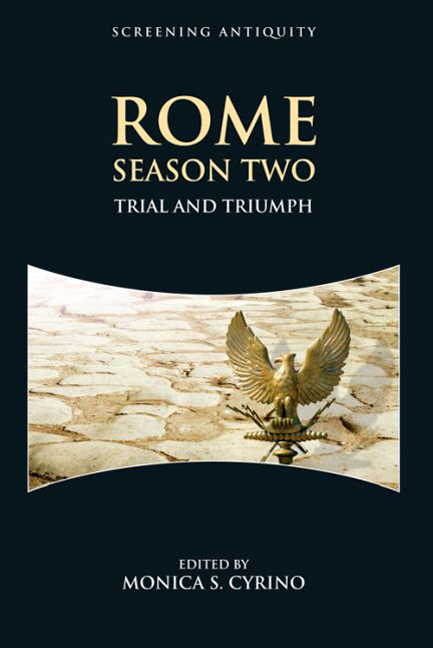Book contents
- Frontmatter
- Contents
- Series Editors’ Preface
- Editor's Acknowledgments
- Contributors
- List of Illustrations
- Episode Listing
- Cast List
- Introduction: The Trials and Triumphs of Rome, Season Two
- PART I POWER AND POLITICS
- 1 A Touch Too Cerebral: Eulogizing Caesar in Rome
- 2 Discharging Pullo and Vorenus: Veterans in Rome
- 3 Gangsterism in Rome
- 4 Class, Chaos, and Control in Rome
- 5 Earning Immortality: Cicero's Death Scene in Rome
- 6 The Triumvirate of the Ring in Rome
- 7 Jews and Judaism in Rome
- PART II Sex and Status
- Filmography
- Bibliography
- Index
6 - The Triumvirate of the Ring in Rome
from PART I - POWER AND POLITICS
Published online by Cambridge University Press: 07 October 2017
- Frontmatter
- Contents
- Series Editors’ Preface
- Editor's Acknowledgments
- Contributors
- List of Illustrations
- Episode Listing
- Cast List
- Introduction: The Trials and Triumphs of Rome, Season Two
- PART I POWER AND POLITICS
- 1 A Touch Too Cerebral: Eulogizing Caesar in Rome
- 2 Discharging Pullo and Vorenus: Veterans in Rome
- 3 Gangsterism in Rome
- 4 Class, Chaos, and Control in Rome
- 5 Earning Immortality: Cicero's Death Scene in Rome
- 6 The Triumvirate of the Ring in Rome
- 7 Jews and Judaism in Rome
- PART II Sex and Status
- Filmography
- Bibliography
- Index
Summary
INTRODUCTION: ENIGMA VARIATIONS
Suetonius reports (Augustus 50) that, early in his career, Octavian used an image of the sphinx to seal letters and other documents. In a discussion of engraved gems, the elder Pliny gives a fuller description of this seal (Natural History 37.10):
In the beginning, the Divine Augustus used a sphinx as his seal. He had found two of these among his mother's rings that were impossible to distinguish. During the civil wars, when he was away, his friends used one of them [i.e., the one he did not keep on his person] to seal letters and official documents which the circumstances of the time required to be rendered in his name; and there was a clever witticism among those receiving these documents to the effect that this sphinx brought riddles (aenigmata).
In a slightly different version of this anecdote, Cassius Dio emphasizes Octavian's agency: according to Dio, Octavian himself had a duplicate of his sphinx seal made for the use of Agrippa and Maecenas, so that they could reseal the letters he wrote to the Senate and others after reading and, when necessary, altering them (Roman History 51.3).
Taken together, the two anecdotes, brief though they are, nicely capture and characterize the studied invention of the Augustan mask, in all its impenetrability and ominous power, from the earliest days of the young heir's ascendancy. Pliny's allusion to the witticism regarding the sphinx's riddles relies on the anecdote's implicit reference to the Theban Sphinx, who killed the would-be solvers of her puzzle until trounced by Oedipus. The replication of the image, whether fortuitously found by Octavian (Pliny) or consciously crafted by him (Dio), also invites interpretation: the literal duality of the sphinx simultaneously evokes a city's salvation by the dead king's son and hints at that city's experience of terror at the hands of the same son. Like Oedipus, Octavian will both save his city and allow terror to run rampant in it.
The creators of Rome use Octavian's early adoption of the sphinx as symbol and seal, much as, at least as our ancient sources suggest, Octavian did himself: to assert his authority, to signal his obscure isolation as a man fated to rule Rome, and to hint at the potential for malignancy behind his calmly enigmatic appearance.
- Type
- Chapter
- Information
- Rome Season TwoTrial and Triumph, pp. 74 - 87Publisher: Edinburgh University PressPrint publication year: 2015



